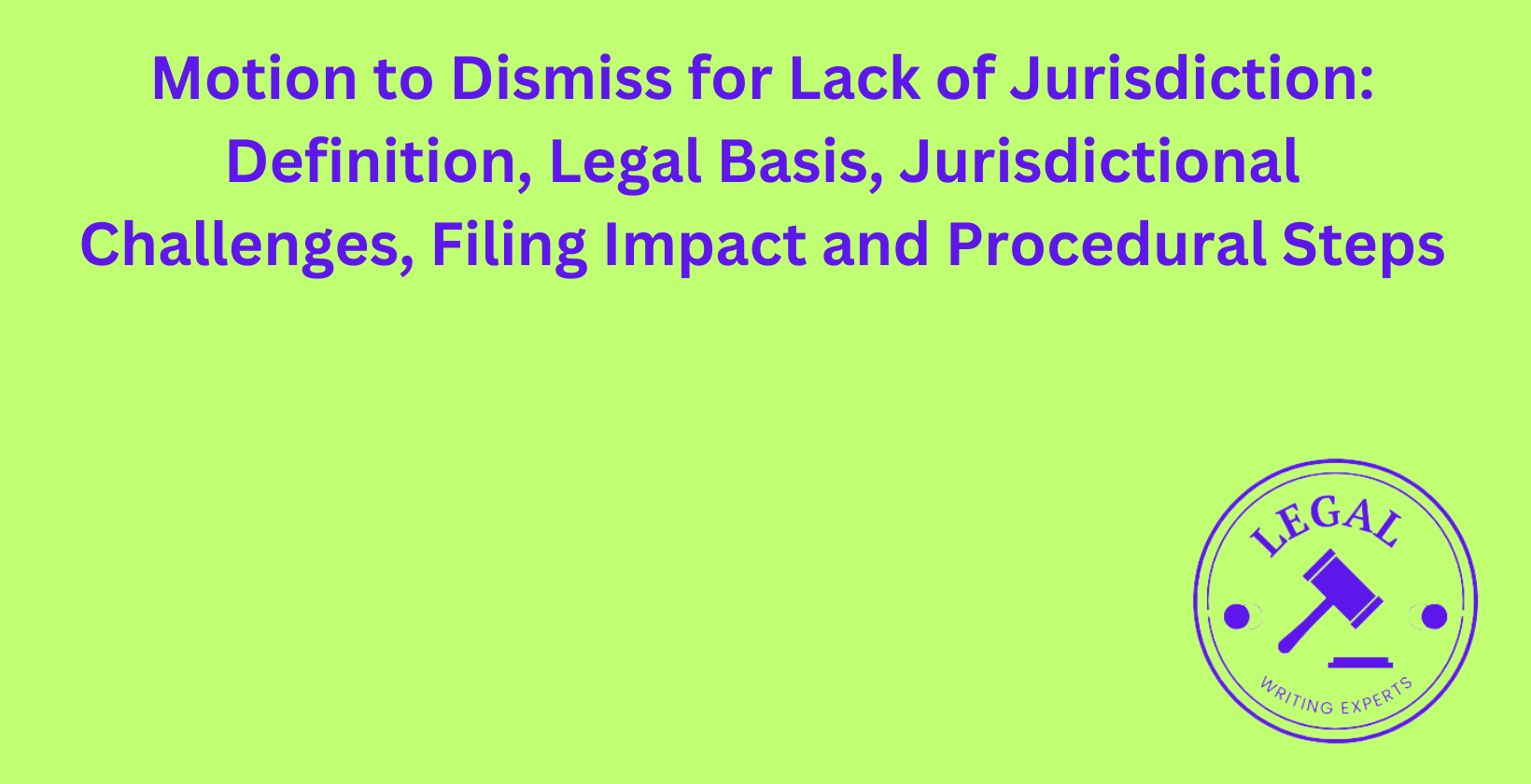Motion to Dismiss for Lack of Jurisdiction
Written by
Jessica E
September 26, 2024 · 8 min read

A motion to dismiss for lack of jurisdiction is a critical legal tool used to challenge a court’s authority to hear a case. This article explores the definition, legal grounds, procedural steps, and strategic implications of filing such a motion. We’ll examine how these motions address both subject matter and personal jurisdiction, their impact on litigation strategy, and the differences between federal and state court standards. The article covers the writing process, filing procedures, potential outcomes, and appeal options for dismissals based on jurisdictional grounds. By understanding these aspects, legal professionals can effectively utilize this motion to protect their clients’ interests and ensure cases are heard in the appropriate forums.
What Is a Motion to Dismiss for Lack of Jurisdiction?
A motion to dismiss for lack of jurisdiction is a legal request made by a defendant arguing that the court does not have the authority to hear or decide the case. This motion challenges the court’s jurisdiction over either the subject matter of the case or the parties involved. It serves as a preliminary objection to the court’s power to adjudicate the dispute, potentially leading to the dismissal of the case without addressing its merits.
How to Write a Motion to Dismiss for Lack of Jurisdiction?
Writing a motion to dismiss for lack of jurisdiction requires a clear and concise presentation of legal arguments. The motion should begin with a statement of the case and the jurisdictional issue at hand. It must include a detailed analysis of the relevant laws and precedents supporting the lack of jurisdiction claim. The writer should cite specific statutes, case law, and constitutional provisions that demonstrate why the court lacks authority over the case. The motion should conclude with a request for the court to dismiss the case for lack of jurisdiction.
Where to Hire a Legal Writer to Draft a Motion to Dismiss for Lack of Jurisdiction?
Legal writers experienced in drafting motions to dismiss for lack of jurisdiction can be found through Legal Writing Experts channel. Legal Writing Experts is a freelance legal writing platform that offers access to independent legal writers. It specializes in providing temporary legal professionals, including writers with expertise in jurisdictional motions.
How to File a Motion to Dismiss for Lack of Jurisdiction?
Filing a motion to dismiss for lack of jurisdiction involves several steps. The motion must be prepared according to the court’s formatting requirements and local rules. It should be filed with the court clerk, typically accompanied by a notice of motion and a memorandum of law supporting the jurisdictional arguments. The filer must serve copies of the motion and supporting documents on all parties involved in the case. Many courts now allow electronic filing, streamlining the submission process. The filing party should confirm the court’s specific procedures and deadlines for motion practice.
What Are the Legal Grounds for Filing a Motion to Dismiss for Lack of Jurisdiction?
The legal grounds for filing a motion to dismiss for lack of jurisdiction include lack of subject matter jurisdiction and lack of personal jurisdiction. Subject matter jurisdiction refers to the court’s authority to hear the type of case presented. Personal jurisdiction pertains to the court’s power over the parties involved. Other grounds may include improper venue, insufficient process, or failure to join an indispensable party. Each ground must be supported by specific legal arguments and factual evidence demonstrating why the court lacks the necessary jurisdiction to proceed with the case.
How Does a Motion to Dismiss for Lack of Jurisdiction Challenge Subject Matter and Personal Jurisdiction?
A motion to dismiss for lack of jurisdiction challenges subject matter jurisdiction by arguing that the court does not have the legal authority to hear the specific type of case. This may involve demonstrating that the case does not meet federal jurisdictional requirements or falls outside the court’s statutory jurisdiction. Personal jurisdiction challenges assert that the court lacks power over the defendant, often due to insufficient contacts with the forum state. These challenges may involve analyzing the defendant’s activities within the jurisdiction and applying relevant long-arm statutes and constitutional due process considerations.
What Are the Procedural Impacts of Filing a Motion to Dismiss for Lack of Jurisdiction?
Filing a motion to dismiss for lack of jurisdiction typically stays other proceedings in the case until the jurisdictional issue is resolved. The motion may pause discovery and other pre-trial activities. The court will usually schedule a hearing to consider the jurisdictional arguments. If granted, the case may be dismissed entirely or transferred to a court with proper jurisdiction. The filing of this motion can significantly extend the timeline of litigation and may lead to early resolution of the case without reaching the merits.
What Happens If a Motion to Dismiss for Lack of Jurisdiction Is Denied?
When a motion to dismiss for lack of jurisdiction is denied, the case proceeds in the current court. The defendant must then file an answer to the complaint within the time specified by court rules. The denial of the motion does not preclude the defendant from raising other defenses or filing subsequent motions on different grounds. In some cases, the defendant may have the right to file an interlocutory appeal challenging the jurisdictional ruling, depending on the jurisdiction and nature of the case.
What Are Common Case Examples Involving Dismissal for Lack of Jurisdiction?
Common case examples involving dismissal for lack of jurisdiction include interstate disputes where personal jurisdiction is contested. For instance, an online transaction between parties in different states may lead to jurisdictional challenges. Cases involving foreign defendants often face personal jurisdiction issues. Subject matter jurisdiction dismissals frequently occur in federal courts when the amount in controversy does not meet the statutory threshold for diversity jurisdiction. Administrative law cases may be dismissed if plaintiffs fail to exhaust administrative remedies before seeking judicial review.
What Are the Differences Between Subject Matter and Personal Jurisdiction?
Subject matter jurisdiction refers to a court’s authority to hear specific types of cases, while personal jurisdiction pertains to a court’s power over the parties involved. Subject matter jurisdiction is determined by the nature of the case and the court’s statutory or constitutional authority. It cannot be waived and can be raised at any time during the proceedings. Personal jurisdiction, on the other hand, relates to the court’s authority over the defendant based on their connections to the forum state. Unlike subject matter jurisdiction, personal jurisdiction can be waived if not timely challenged.
What Are the Legal Standards for Jurisdictional Challenges in Federal and State Courts?
Legal standards for jurisdictional challenges vary between federal and state courts. In federal courts, subject matter jurisdiction is limited by Article III of the Constitution and statutory grants of authority. Federal courts apply the “minimum contacts” test for personal jurisdiction, as established in International Shoe Co. v. Washington. State courts, as courts of general jurisdiction, have broader subject matter jurisdiction. State long-arm statutes govern personal jurisdiction in state courts, but these must comply with federal due process standards. Both federal and state courts require that jurisdictional challenges be supported by clear and convincing evidence.
What Are the Filing Timelines for a Motion to Dismiss for Lack of Jurisdiction?
Filing timelines for a motion to dismiss for lack of jurisdiction vary by jurisdiction but generally must be made early in the litigation process. In federal courts, Rule 12(b) of the Federal Rules of Civil Procedure requires that such motions be filed before or with the answer to the complaint. Many state courts have similar rules. Failure to timely raise jurisdictional objections may result in waiver of the defense, particularly for personal jurisdiction challenges. Subject matter jurisdiction issues can typically be raised at any time during the proceedings, even on appeal.
How Does a Motion to Dismiss Impact Litigation Strategy?
A motion to dismiss for lack of jurisdiction significantly impacts litigation strategy. It can provide an early exit from unfavorable forums or delay proceedings to gain tactical advantages. The motion forces plaintiffs to justify their choice of forum and may reveal weaknesses in their case. Defendants must weigh the potential benefits of a successful motion against the costs and delays associated with jurisdictional challenges. The decision to file this motion can affect settlement negotiations and the overall trajectory of the case.
How to Appeal a Dismissal for Lack of Jurisdiction?
Appealing a dismissal for lack of jurisdiction involves filing a notice of appeal with the trial court within the specified time frame, typically 30 days after the entry of judgment. The appellant must then prepare and file an appellate brief arguing that the lower court erred in its jurisdictional determination. The appeal will focus on legal arguments rather than factual disputes, as appellate courts generally review jurisdictional issues de novo. The appellant must demonstrate that the trial court misapplied the law or made clear errors in its jurisdictional analysis. Successful appeals may result in the case being remanded to the lower court for further proceedings.
Meet the Author
Distinguished linguist at Legal Writing Experts
Jessica is an expert legal writer with a remarkable blend of legal knowledge and linguistic precision. She earned her Juris Doctor degree from Duke University, where she attended on a prestigious Law Faculty Merit Scholarship. At Duke, Jessica demonstrated her exceptional abilities by serving as an editor of the Duke Law Review.
After graduating, Jessica further refined her skills during a two-year appellate clerkship at a distinguished law firm in North Carolina. Throughout law school, she enhanced her research and writing expertise as a research assistant and writer for various legal firms. Jessica’s deep understanding of legal language and meticulous attention to detail make her an invaluable asset to our legal writing services.


